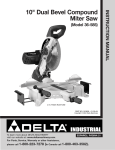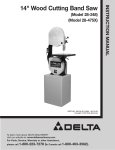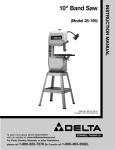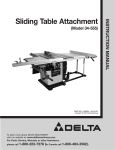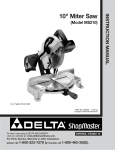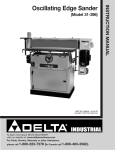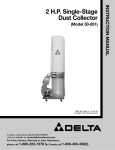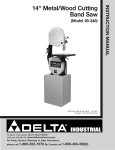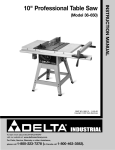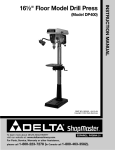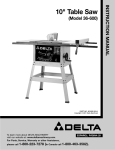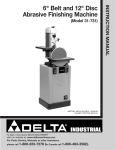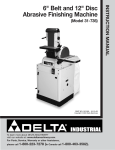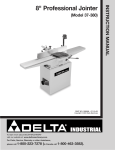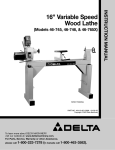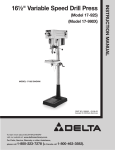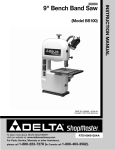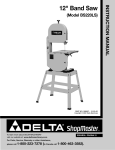Download Delta 32-326 Instruction manual
Transcript
(Model 32-325) 13-Spindle Pneumatic Line Boring Machine (Model 32-326) Model 32-325 Shown with Accessory 32-331 Stand Model 32-326 Shown with Accessory 32-331 Stand PART NO. 449-01-651-0005 - 11-03-03 Copyright © 2003 Delta Machinery To learn more about DELTA MACHINERY visit our website at: www.deltamachinery.com. For Parts, Service, Warranty or other Assistance, please call 1-800-223-7278 (In Canada call 1-800-463-3582). INSTRUCTION MANUAL 13-Spindle Line Boring Machine SAFETY GUIDELINES - DEFINITIONS This manual contains information that is important for you to know and understand. This information relates to protecting YOUR SAFETY and PREVENTING EQUIPMENT PROBLEMS. To help you recognize this information, we use the symbols to the right. Please read the manual and pay attention to these sections. Indicates an imminently hazardous situation which, if not avoided, will result in death or serious injury. Indicates a potentially hazardous situation which, if not avoided, could result in death or serious injury. Indicates a potentially hazardous situation which, if not avoided, may result in minor or moderate injury. Used without the safety alert symbol indicates potentially hazardous situation which, if not avoided, may result in property damage. SOME DUST CREATED BY POWER SANDING, SAWING, GRINDING, DRILLING, AND OTHER CONSTRUCTION ACTIVITIES contains chemicals known to cause cancer, birth defects or other reproductive harm. Some examples of these chemicals are: · lead from lead-based paints, · crystalline silica from bricks and cement and other masonry products, and · arsenic and chromium from chemically-treated lumber. Your risk from these exposures varies, depending on how often you do this type of work. To reduce your exposure to these chemicals: work in a well ventilated area, and work with approved safety equipment, always wear MSHA/NIOSH approved, properly fitting face mask or respirator when using such tools. GENERAL SAFETY RULES READ AND UNDERSTAND ALL WARNINGS AND OPERATING INSTRUCTIONS BEFORE USING THIS EQUIPMENT. Failure to follow all instructions listed below, may result in electric shock, fire, and/or serious personal injury or property damage. IMPORTANT SAFETY INSTRUCTIONS Woodworking can be dangerous if safe and proper operating procedures are not followed. As with all machinery, there are certain hazards involved with the operation of the product. Using the machine with respect and caution will considerably lessen the possibility of personal injury. However, if normal safety precautions are overlooked or ignored, personal injury to the operator may result. Safety equipment such as guards, push sticks, hold-downs, featherboards, goggles, dust masks and hearing protection can reduce your potential for injury. But even the best guard won’t make up for poor judgment, carelessness or inattention. Always use common sense and exercise caution in the workshop. If a procedure feels dangerous, don’t try it. Figure out an alternative procedure that feels safer. REMEMBER: Your personal safety is your responsibility. For additional information please visit our website www.deltamachinery.com. This machine was designed for certain applications only. Delta Machinery strongly recommends that this machine not be modified and/or used for any application other than that for which it was designed. If you have any questions relative to a particular application, DO NOT use the machine until you have first contacted Delta to determine if it can or should be performed on the product. Technical Service Manager Delta Machinery 4825 Highway 45 North Jackson, TN 38305 (IN CANADA: 505 SOUTHGATE DRIVE, GUELPH, ONTARIO N1H 6M7) 2 FAILURE TO FOLLOW THESE RULES MAY RESULT IN SERIOUS PERSONAL INJURY. 12. USE THE RIGHT MACHINE. Don’t force a machine or an attachment to do a job for which it was not designed. Damage to the machine and/or injury may result. 13. USE RECOMMENDED ACCESSORIES. The use of accessories and attachments not recommended by Delta may cause damage to the machine or injury to the user. 14. USE THE PROPER EXTENSION CORD. Make sure your extension cord is in good condition. When using an extension cord, be sure to use one heavy enough to carry the current your product will draw. An undersized cord will cause a drop in line voltage, resulting in loss of power and overheating. See the Extension Cord Chart for the correct size depending on the cord length and nameplate ampere rating. If in doubt, use the next heavier gauge. The smaller the gauge number, the heavier the cord. 15. SECURE THE WORKPIECE. Use clamps or a vise to hold the workpiece when practical. Loss of control of a workpiece can cause injury. 16. FEED THE WORKPIECE AGAINST THE DIRECTION OF THE ROTATION OF THE BLADE, CUTTER, OR ABRASIVE SURFACE. Feeding it from the other direction will cause the workpiece to be thrown out at high speed. 17. DON’T FORCE THE WORKPIECE ON THE MACHINE. Damage to the machine and/or injury may result. 18. DON’T OVERREACH. Loss of balance can make you fall into a working machine, causing injury. 19. NEVER STAND ON THE MACHINE. Injury could occur if the tool tips, or if you accidentally contact the cutting tool. 20. NEVER LEAVE THE MACHINE RUNNING UNATTENDED. TURN THE POWER OFF. Don’t leave the machine until it comes to a complete stop. A child or visitor could be injured. 21. TURN THE MACHINE “OFF”, AND DISCONNECT THE MACHINE FROM THE POWER SOURCE before installing or removing accessories, before adjusting or changing set-ups, or when making repairs. An accidental start-up can cause injury. 22. MAKE YOUR WORKSHOP CHILDPROOF WITH PADLOCKS, MASTER SWITCHES, OR BY REMOVING STARTER KEYS. The accidental start-up of a machine by a child or visitor could cause injury. 23. STAY ALERT, WATCH WHAT YOU ARE DOING, AND USE COMMON SENSE. DO NOT USE THE MACHINE WHEN YOU ARE TIRED OR UNDER THE INFLUENCE OF DRUGS, ALCOHOL, OR MEDICATION. A moment of inattention while operating power tools may result in injury. 24. THE DUST GENERATED by certain woods and wood products can be injurious to your health. Always operate machinery in well-ventilated areas, and provide for proper dust removal. Use wood dust collection systems whenever possible. 1. FOR YOUR OWN SAFETY, READ THE INSTRUCTION MANUAL BEFORE OPERATING THE MACHINE. Learning the machine’s application, limitations, and specific hazards will greatly minimize the possibility of accidents and injury. 2. WEAR EYE PROTECTION. ALWAYS USE SAFETY GLASSES. Also use face or dust mask if cutting operation is dusty. Everyday eyeglasses are NOT safety glasses. USE CERTIFIED SAFETY EQUIPMENT. Eye protection equipment should comply with ANSI Z87.1 standards, hearing equipment should comply with ANSI S3.19 standards, and dust mask protection should comply with MSHA/NIOSH certified respirator standards. Splinters, air-borne debris, and dust can cause irritation, injury, and/or illness. 3. WEAR PROPER APPAREL. Do not wear loose clothing, gloves, neckties, rings, bracelets, or other jewelry which may get caught in moving parts. Nonslip footwear is recommended. Wear protective hair covering to contain long hair. 4. DO NOT USE THE MACHINE IN A DANGEROUS ENVIRONMENT. The use of power tools in damp or wet locations or in rain can cause shock or electrocution. Keep your work area well-lit to prevent tripping or placing arms, hands, and fingers in danger. 5. MAINTAIN ALL TOOLS AND MACHINES IN PEAK CONDITION. Keep tools sharp and clean for best and safest performance. Follow instructions for lubricating and changing accessories. Poorly maintained tools and machines can further damage the tool or machine and/or cause injury. 6. CHECK FOR DAMAGED PARTS. Before using the machine, check for any damaged parts. Check for alignment of moving parts, binding of moving parts, breakage of parts, and any other conditions that may affect its operation. A guard or any other part that is damaged should be properly repaired or replaced. Damaged parts can cause further damage to the machine and/or injury. 7. KEEP THE WORK AREA CLEAN. Cluttered areas and benches invite accidents. 8. KEEP CHILDREN AND VISITORS AWAY. Your shop is a potentially dangerous environment. Children and visitors can be injured. 9. REDUCE THE RISK OF UNINTENTIONAL STARTING. Make sure that the switch is in the “OFF” position before plugging in the power cord. In the event of a power failure, move the switch to the “OFF” position. An accidental start-up can cause injury. 10. USE THE GUARDS. Check to see that all guards are in place, secured, and working correctly to prevent injury. 11. REMOVE ADJUSTING KEYS AND WRENCHES BEFORE STARTING THE MACHINE. Tools, scrap pieces, and other debris can be thrown at high speed, causing injury. 3 ADDITIONAL SAFETY RULES FOR LINE BORING MACHINES FAILURE TO FOLLOW THESE RULES MAY RESULT IN SERIOUS PERSONAL INJURY. 1. 2. 3. 4. 5. 6. 7. 8. 9. 10. 11. 12. DO NOT OPERATE THIS MACHINE until it is completely assembled and installed according to the instructions. A machine incorrectly assembled can cause serious injury. OBTAIN ADVICE from your supervisor, instructor, or another qualified person if you are not thoroughly familiar with the operation of this machine. Knowledge is safety. FOLLOW ALL WIRING CODES and recommended electrical connections to prevent shock or electrocution. SECURE THE MACHINE TO A SUPPORTING SURFACE. Vibration can cause the machine to slide, walk, or tip over. NEVER START THE MACHINE BEFORE CLEARING THE TABLE OF ALL OBJECTS (tools, scrap pieces, etc.). Debris can be thrown at high speed. NEVER START THE MACHINE with the drill bit, cutting tool, or sanding drum against the workpiece. Loss of control of the workpiece can cause serious injury. PROPERLY LOCK THE DRILL BIT, CUTTING TOOL, OR SANDING DRUM IN THE CHUCK before operating this machine. REMOVE THE CHUCK KEY BEFORE STARTING THE MACHINE. The chuck key can be thrown out at a high speed. TIGHTEN ALL LOCK HANDLES before starting the machine. Loss of control of the workpiece can cause serious injury. USE ONLY DRILL BITS, CUTTING TOOLS, SANDING DRUMS, OR OTHER ACCESSORIES with shank size recommended in your instruction manual. The wrong size accessory can cause damage to the machine and/or serious injury. USE ONLY DRILL BITS, CUTTING TOOLS, OR SANDING DRUMS that are not damaged. Damaged items can cause malfunctions that lead to injuries. USE RECOMMENDED SPEEDS for all operations. Other speeds may cause the machine to malfunction causing damage to the machine and/or serious injury. 13. 14. 15. 16. 17. 18. 19. 20. AVOID AWKWARD OPERATIONS AND HAND POSITIONS. A sudden slip could cause a hand to move into the bit. KEEP ARMS, HANDS, AND FINGERS away from the bit. Serious injury to the hand can occur. HOLD THE WORKPIECE FIRMLY AGAINST THE TABLE. Do not attempt to drill a workpiece that does not have a flat surface against the table, or that is not secured by a vise. Prevent the workpiece from rotating by clamping it to the table. Loss of control of the workpiece can cause serious injury. TURN THE MACHINE “OFF” AND WAIT FOR THE DRILL BIT, CUTTING TOOL, OR SANDING DRUM TO STOP TURNING prior to cleaning the work area, removing debris, removing or securing work-piece, or changing the angle of the table. A moving drill bit, cutting tool, or sanding drum can cause serious injury. PROPERLY SUPPORT LONG OR WIDE workpieces. Loss of control of the workpiece can cause severe injury. NEVER PERFORM LAYOUT, ASSEMBLY OR SET-UP WORK on the table/work area when the machine is running. Serious injury can result. TURN THE MACHINE “OFF”, disconnect the machine from the power source, and clean the table/work area before leaving the machine. LOCK THE SWITCH IN THE “OFF” POSITION to prevent unauthorized use. Someone else might accidentally start the machine and cause serious injury to themselves. ADDITIONAL INFORMATION regarding the safe and proper operation of power tools (i.e. a safety video) is available from the Power Tool Institute, 1300 Sumner Avenue, Cleveland, OH 44115-2851 (www.powertoolinstitute.com). Information is also available from the National Safety Council, 1121 Spring Lake Drive, Itasca, IL 60143-3201. Please refer to the American National Standards Institute ANSI 01.1 Safety Requirements for Woodworking Machines and the U.S. Department of Labor OSHA 1910.213 Regulations. SAVE THESE INSTRUCTIONS. Refer to them often and use them to instruct others. 4 POWER CONNECTIONS A separate electrical circuit should be used for your machines. This circuit should not be less than #12 wire and should be protected with a 20 Amp time lag fuse. If an extension cord is used, use only 3-wire extension cords which have 3prong grounding type plugs and matching receptacle which will accept the machine’s plug. Before connecting the machine to the power line, make sure the switch is in the “OFF” position and be sure that the electric current is of the same characteristics as indicated on the machine. All line connections should make good contact. Running on low voltage will damage the machine. DO NOT EXPOSE THE MACHINE TO RAIN OR OPERATE THE MACHINE IN DAMP LOCATIONS. MOTOR SPECIFICATIONS Your machine is wired for 120 volt, 60 HZ alternating current. Before connecting the machine to the power source, make sure the switch is in the “OFF” position. GROUNDING INSTRUCTIONS THIS MACHINE MUST BE GROUNDED WHILE IN USE TO PROTECT THE OPERATOR FROM ELECTRIC SHOCK. 1. All grounded, cord-connected machines: 2. Grounded, cord-connected machines intended for use on a supply circuit having a nominal rating less than 150 volts: In the event of a malfunction or breakdown, grounding provides a path of least resistance for electric current to reduce the risk of electric shock. This machine is equipped with an electric cord having an equipmentgrounding conductor and a grounding plug. The plug must be plugged into a matching outlet that is properly installed and grounded in accordance with all local codes and ordinances. If the machine is intended for use on a circuit that has an outlet that looks like the one illustrated in Fig. A, the machine will have a grounding plug that looks like the plug illustrated in Fig. A. A temporary adapter, which looks like the adapter illustrated in Fig. B, may be used to connect this plug to a matching 2-conductor receptacle as shown in Fig. B if a properly grounded outlet is not available. The temporary adapter should be used only until a properly grounded outlet can be installed by a qualified electrician. The green-colored rigid ear, lug, and the like, extending from the adapter must be connected to a permanent ground such as a properly grounded outlet box. Whenever the adapter is used, it must be held in place with a metal screw. Do not modify the plug provided - if it will not fit the outlet, have the proper outlet installed by a qualified electrician. Improper connection of the equipment-grounding conductor can result in risk of electric shock. The conductor with insulation having an outer surface that is green with or without yellow stripes is the equipmentgrounding conductor. If repair or replacement of the electric cord or plug is necessary, do not connect the equipment-grounding conductor to a live terminal. NOTE: In Canada, the use of a temporary adapter is not permitted by the Canadian Electric Code. Check with a qualified electrician or service personnel if t h e g ro u n d i n g i n s t r u c t i o n s a re n o t c o m p l e t e l y understood, or if in doubt as to whether the machine is properly grounded. IN ALL CASES, MAKE CERTAIN THE R E C E P TA C L E I N Q U E S T I O N I S P R O P E R LY G R O U N D E D . I F Y O U A R E N O T S U R E H AV E A QUALIFIED ELECTRICIAN CHECK THE RECEPTACLE. Use only 3-wire extension cords that have 3-prong grounding type plugs and matching 3-conductor receptacles that accept the machine’s plug, as shown in Fig. A. Repair or replace damaged or worn cord immediately. GROUNDED OUTLET BOX GROUNDED OUTLET BOX GROUNDING MEANS CURRENT CARRYING PRONGS ADAPTER GROUNDING BLADE IS LONGEST OF THE 3 BLADES Fig. A 5 Fig. B EXTENSION CORDS Use proper extension cords. Make sure your extension cord is in good condition and is a 3-wire extension cord which has a 3-prong grounding type plug and matching receptacle which will accept the machine’s plug. When using an extension cord, be sure to use one heavy enough to carry the current of the machine. An undersized cord will cause a drop in line voltage, resulting in loss of power and overheating. Fig. D, shows the correct gauge to use depending on the cord length. If in doubt, use the next heavier gauge. The smaller the gauge number, the heavier the cord. MINIMUM GAUGE EXTENSION CORD RECOMMENDED SIZES FOR USE WITH STATIONARY ELECTRIC MACHINES Ampere Rating Volts Total Length of Cord in Feet Gauge of Extension Cord 0-6 0-6 0-6 0-6 120 120 120 120 up to 25 25-50 50-100 100-150 18 AWG 16 AWG 16 AWG 14 AWG 6-10 6-10 6-10 6-10 120 120 120 120 up to 25 25-50 50-100 100-150 18 AWG 16 AWG 14 AWG 12 AWG 10-12 10-12 10-12 10-12 120 120 120 120 up to 25 25-50 50-100 100-150 16 AWG 16 AWG 14 AWG 12 AWG 12-16 12-16 12-16 120 120 120 up to 25 25-50 14 AWG 12 AWG GREATER THAN 50 FEET NOT RECOMMENDED Fig. D FUNCTIONAL DESCRIPTION FOREWORD Delta Models 32-325 & 32-326 are line boring machines. These line boring machines come with a large, 16"x29¾" table, which provides a large work space in front of the boring head for boring extra large boards. NOTICE: THE MANUAL COVER PHOTO ILLUSTRATES THE CURRENT PRODUCTION MODEL. ALL OTHER ILLUSTRATIONS ARE REPRESENTATIVE ONLY AND MAY NOT DEPICT THE ACTUAL COLOR, LABELING OR ACCESSORIES AND MAY BE INTENDED TO ILLUSTRATE TECHNIQUE ONLY. UNPACKING AND CLEANING Carefully unpack the machine and all loose items from the shipping container(s). Remove the protective coating from all unpainted surfaces. This coating may be removed with a soft cloth moistened with kerosene (do not use acetone, gasoline or lacquer thinner for this purpose). After cleaning, cover the unpainted surfaces with a good quality household floor paste wax. 6 CARTON CONTENTS INSTRUCTIONS LISTED AND SHOWN IN THIS MANUAL REFER TO BOTH THE 32-325 13-SPINDLE LINE BORING MACHINE AND 32-326 13-SPINDLE PNEUMATIC LINE BORING MACHINE UNLESS OTHERWISE NOTED. For Model 32-325 13-Spindle Line Boring Machine 1 2 5 3 4 8 6 7 Fig. 2 1 - Boring Machine 2 - Fence 3 - Table 4 - Clear Plastic Guard 5 - Lowering and Raising Handle 6 - Table Brackets 7 - Wrench 8 - Gage for Aligning Fence to Drill Head 7 For 32-326 13-Spindle Pneumatic Line Boring Machine 10 - Pneumatic Boring Machine 10 11 11 - Fence 12 - Table 13 - Clear Plastic Guard 14 - Table Brackets 15 - Wrench 12 16 - Gage for Aligning Fence to Drill Head 15 16 13 14 Fig. 3 18 - Table Bracket Slides (4) 19 - Spacers (2) For 32-325 13-Spindle Line Boring Machine For 32-326 13-Spindle Pneumatic Line Boring Machine 20 - 1/4" Flat Washers (2) 23 19 21 - 1/4" Lockwashers (2) 22 - 1/4-20x1-1/2" Hex Screws (2) 24 18 23 - Table Lock Knobs (2) 20 24 - 5/16" Flat Washers (2) 25 21 22 25 - 5/16-18x3/4" Carriage Bolts (2) 26 26 - 1/4-20 Hex Lock Nuts (4) 27 27 - 1/4-20x1-1/4" Flat Head Screws (4) 28 28 - 5/16-24x1/4" Hex Set Screws (13) Fig. 4 For 32-326 13-Spindle Pneumatic Line Boring Machine 32 30 - 1/4-20x1-1/4" Flat Head Screws (4) 31 - 1/4-20 Hex Lock Nuts (4) 32 - Air Clamp Brackets (2) 35 33 - Air Clamps (2) 34 - Rubber Feet for Air Clamps (2) 33 35 - Air Cylinder 31 36 - Guard 37 - 1-3/8"-12 Hex Nut 34 30 38 - Air Filter 38 36 37 Fig. 5 8 ASSEMBLY FOR YOUR OWN SAFETY, DO NOT CONNECT THE MACHINE TO THE POWER SOURCE UNTIL THE MACHINE IS COMPLETELY ASSEMBLED AND YOU READ AND UNDERSTAND THE ENTIRE INSTRUCTION MANUAL. ACCESSORY 32-331 STAND A B If you purchased the accessory 32-331 steel stand for use with your boring machine, assemble the stand as shown in Fig. 6, using thirty-two 5/8" long carriage bolts, flat washers and hex nuts. Align the holes in the legs with the holes in the braces, insert a 5/16-18x5/8" carriage bolt through the hole in the leg and the hole in the brace, place a 5/16" flat washer onto the carriage bolt and thread a 5/16-18 hex nut onto the carriage bolt and hand tighten. Repeat this process for the thirty-one remaining holes. NOTE: All braces mount to the inside of the legs. NOTE: For ease in identifying and assembling the stand, the two top front and rear braces (A) are 13-1/2" long; the two top side braces (B) are 16-1/2" long; the two bottom front and rear braces (C) are 19-1/2" long; and the two bottom side braces (D) are 22-1/2" long. The four legs (E) are 31-1/2" long. NOTE: Do not completely tighten the stand mounting hardware until the machine is assembled to the stand. Assemble the four plastic feet (G) to the bottom of each leg (E) as shown. E B A C D D C G Fig. 6 MACHINE TO STAND If you purchased the accessory 32-331 steel stand for use with your boring machine, assemble the machine to the stand using four 5/16-18x3/4" hex head screws, one of which is shown at (A) Fig. 7, 5/16" flat washers, 5/16" lockwashers and 5/16-18 hex nuts supplied with the accessory stand. NOTE: Align the four holes in the machine with the four holes in the stand. Insert the 3/4" hex head screw through the top of the machine and stand, place a flat washer onto the 3/4" hex head screw, then place a lockwasher onto the 3/4" hex head screw, and thread a nut onto the screw and tighten securely. Repeat this process for the three remaining holes. A Fig. 7 FASTENING MACHINE TO A SUPPORTING SURFACE If you are using the boring machine without the accessory 32-331 steel stand, the machine MUST be fastened to a supporting surface using suitable hardware, not supplied by Delta. 9 B C A Fig. 8 Fig. 9 TABLE TO MACHINE F 1. Clip the two table slides (A) Fig. 8, to the table bracket (B) as shown. C 2. Clip the remaining two table slides to the other table bracket in the same manner. 3. Center table (C) Fig. 9, on the machine frame as shown. B 4. Position table bracket (B) Fig. 10, against machine frame (D) and underneath table (C) as shown, lining up the two holes (E) Fig. 11, in the table with the two holes (F) Fig. 10, on top of table bracket (B) Fig. 10. D Fig. 10 5. Fasten the table to the table bracket using the two 1/4-20x1-1/4" flat head screws (E) Fig. 11, and two 1/420 lock nuts (F) Fig. 10. NOTE: DO NOT TIGHTEN HARDWARE AT THIS TIME. E 6. Assemble the remaining table bracket to the other side of the table and frame in the same manner. 7. Insert the 5/16-18x3/4" carriage bolt (G) Fig. 12, up through square hole (H) and slot (J) as shown, and fasten in place using the 5/16" flat washer (K) Fig. 13 and lock knob (L). NOTE: DO NOT TIGHTEN HARDWARE AT THIS TIME. Fig. 11 L H J K G Fig. 12 Fig. 13 10 FENCE TO MACHINE 1. Place spacer (A) Fig. 14, over hole (B) in table bracket with large countersunk end of spacer (A) in the up position. 2. Place a 1/4" lockwasher (C) Fig. 14, and a 1/4" flat washer (D) on the 1/4-20x1-1/2" hex head screw (E) and insert screw (E) up through hole (B) in table bracket and through hole in spacer (A). Thread screw (E) into threaded hole (F) on bottom of fence. NOTE: DO NOT TIGHTEN HARDWARE AT THIS TIME. A F E D B C Fig. 14 3. Assemble remaining spacer to opposite end of fence in the same manner. 4. Figure 15 illustrates the fence (G) assembled to the table bracket. NOTE: DO NOT COMPLETELY TIGHTEN THE TWO SCREWS, ONE OF WHICH IS SHOWN AT (E), AT THIS TIME. G E Fig. 15 D D ALIGNING FENCE PARALLEL TO LINE BORING HEAD B 1. Set the right fence stop to 9 inches on the fence scale and the left fence stop should be moved out beyond the 9 inch mark. Position gage (A) Fig. 16, on table as shown, with points of both indexing pins (B) over holes (C) in gage. 2. Unscrew and remove knobs (D) Fig. 16, from top of indexing pins. 3. Allow indexing pins (B) Fig. 17, to lower until points of indexing pins engage the two holes in gage (A) as shown. C A B C Fig. 16 B A B Fig. 17 11 E F B H A L K G F G Fig. 18 4. With index pins (B) Fig. 18, engaged with holes in gage (A), loosen table lock knobs, one of which is shown at (E), and move table until front end of fence (F) is approximately 1/32" away from gage at point (G) on each end of the gage. Then tighten the table lock knobs (E). 5. Using a small “C” clamp (not supplied), secure table bracket (K) Fig. 18, to machine frame (L) at a point between the two sides to avoid movement. Clamp the other table bracket to the machine frame in the same manner at the other side of the machine. Fig. 19 6. Loosen the two screws (E) Fig. 15, that fasten fence (F) Fig. 19, to the machine and move fence (F) until front surface of fence contacts gage at point (G) as shown, at each end of the gage. Move the fence left or right until the right fence stop, that was set in STEP 1, contacts the gage at point (H). Then tighten the fence mounting hardware. NOTE: FENCE STOP IS NOT SHOWN FOR CLARITY. 7. Refer to the following instructions “ADJUSTING TABLE PARALLEL TO FENCE.” B A ADJUSTING TABLE PARALLEL TO FENCE B C C A 1. Remove the gage (A) Fig. 18. The points of the index pins (B) Fig. 18, should point to the 2-1/4" mark on both scales. Fig. 20 2. If an adjustment is necessary, loosen four screws (C) Fig. 20, that fasten the table to the machine frame and adjust the table until index pins (B) point to the 2-1/4" mark on scales (A). IMPORTANT: Make sure the table mounting brackets are held securely against the machine frame and tighten four screws (C). D D B 3. Replace knobs (D) Fig. 21, to top of indexing pins (B) as shown. B NOTE: The space between the rear of the table and the front of the fence is for chip removal. 4. Remove two clamps temporarily assembled in STEP 5 of section “ALIGNING FENCE PARALLEL TO LINE BORING HEAD.” Fig. 21 12 C A B A Fig. 22 Fig. 23 ASSEMBLING HEAD LOWERING AND RAISING HANDLE (For 32-325 Line Boring Machine Only) 1. Remove retaining ring (A) Fig. 22, and remove connecting pin (B). 2. Insert end of handle (C) Fig. 23, into head assembly as shown and fasten handle in place by reassembling connecting pin that was removed in STEP 1, through hole in end of handle. Replace retaining ring (A). A B Fig. 24 ASSEMBLING HEAD LOWERING AND RAISING AIR CYLINDER D (For 32-326 Pneumatic Line Boring Machine Only) 1. Remove retaining ring (A) Fig. 24, and connecting pin (B). 2. Place guard (C) Fig. 25, under bracket (D) as shown. C 3. Assemble end of air cylinder (E) Fig. 26, down through hole in top of bracket (D) and through hole in guard that was held in place in STEP 2. Using the 1-3/8" hex nut (F), fasten air cylinder in place by turning air cylinder (E) and nut (F). Make certain the guard that was held in place in STEP 2, does not contact the head assembly after tightening hex nut (F). NOTE: Air fittings (G) and (H) should point to the rear of the machine as shown. Make certain hex nut (F) is positioned so the flat on the nut is parallel to front of support bracket (D). Fig. 25 G X E H D F THE FLAT ON THE NUT (F) MUST BE PARALLEL TO THE FRONT OF SUPPORT BRACKET (D), IF NUT IS NOT PARALLEL TO THE SUPPORT BRACKET THE NUT WILL BIND AGAINST SLIDE PLATE (X) WHILE OPERATING. Fig. 26 13 G E S K F D L H V N R R A B Fig. 27 4. Make certain air cylinder rod is retracted completely into cylinder (E) Fig. 27. Loosen locknut (K) Fig. 27, and unscrew hex end of clevis rod (L) until holes line up with holes in bracket (N). Using retaining clip (A) and retaining pin (B), which were removed in STEP 1, fasten clevis (L) to bracket (N). Retighten locknut (K) Fig. 27. NOTE: It may be necessary to loosen screws (R) Fig. 28, in order to get pin to line up with clevis. Fig. 28 A B 5. Insert black air supply line (S) Fig. 28, into top fitting (G) of the air cylinder and blue air supply line (V) into bottom fitting (H) of the air cylinder as shown. NOTE: Push end of air lines as far as they will go into the fittings. C Fig. 29 ASSEMBLING TABLE AIR CYLINDER CLAMPS A (For 32-326 Pneumatic Line Boring Machine Only) 1. Assemble clamp bracket (A) Fig. 29, to bottom of table using two 1/4-20x1-1/4" flat head screws (B) and 1/4-20 hex lock nuts (C). 2. Figure 30 illustrates one of the two clamp brackets (A) assembled to the table with the two 1-1/4" long flat head screws (B). Assemble remaining clamp bracket to other end of table in the same manner. B Fig. 30 E A E A D F D Fig. 31 Fig. 32 14 3. Remove jam nut (D) Fig. 31, from bottom end of air cylinder clamp (E) and assemble air cylinder clamp (E) Fig. 32, to clamp bracket (A) Fig. 31, using jam nut (D). Thread rubber foot (F) Fig. 32, onto bottom of air cylinder clamp (E) as shown. Assemble remaining air cylinder clamp to other clamp bracket in the same manner. G H E 4. Insert red air lines (G) Fig. 33, into air fittings (H) located on top of each air cylinder clamp (E). Push end of air line (G), as far as it will go into fitting (H). Fig. 33 ASSEMBLING AIR FILTER (For 32-326 Pneumatic Line Boring Machine Only) B Thread air filter (A) Fig. 34, onto threaded stud (C) on side of air and electric control box (B) as shown. A 1/4" female pipe thread is supplied on both sides of the air filter for connecting the air filter to the threaded stud as shown, and for connecting air to the machine. NOTE: An air flow directional arrow is supplied on the filter to help insure correct assembly. NOTE: Quick connect (D) is not supplied with the machine. D C A Fig. 34 ASSEMBLING BORING BITS TO SPINDLES NOTE: THIS MACHINE WILL ONLY ACCEPT BITS WITH 10MM SHANKS. A 1. Thirteen set screws (A) are supplied with your machine and are to be threaded partway into each spindle, as shown in Fig. 35, with T-wrench supplied. 2. Insert boring bits (B) Fig. 36 (not supplied with boring machine), into spindles (C). Push bit (B) in as far as possible and tighten set screws (A) against flat on bit. Fig. 35 NOTE: With the 13-Spindle Boring Machine, thirteen bits are required, seven right hand rotation and six left hand rotation. A right hand rotation bit is inserted into the center spindle and every other spindle to the right and left. Insert left hand rotation bits into the remaining spindles. Fig. 36 illustrates all thirteen bits assembled to the boring head. A C B Fig. 36 15 ALIGNING BORING BITS (For 32-325 Line Boring Machine Only) 1. Place a flat piece of wood (A) Fig. 37, on the table and against the fence as shown. Pull operating handle downward until ANY ONE boring bit (B) first contacts the top of the wood surface (A). NOTE: If all boring bits (B) contact the top surface of the wood at the same time, no alignment is necessary. 2. If any of the boring bits (B) Fig. 37, are not contacting the wood surface (A), remove each bit that does not contact the board one at a time. Loosen the set screw in the shank end of the bit by the same amount that the bit does not contact the wood. Reassemble the bit into the same spindle as far as it will go, and tighten the spindle set screw. After all bits have been adjusted, go back to step 1 and recheck the alignment. B A Fig. 37 ALIGNING BORING BITS (For 32-326 Pneumatic Line Boring Machine Only) 1. Cut a straight piece of wood (A) Fig. 38, two inches high by sixteen inches long. Place the wood (A) on the table directly underneath the 13 boring bits (B) as shown. 2. If any of the boring bits (B) Fig. 38, are not contacting the wood surface (A), remove each bit that does not contact the board one at a time. Loosen the set screw in the shank end of the bit by the same amount that the bit does not contact the wood. Reassemble the bit into the same spindle as far as it will go, and tighten the spindle set screw. After all bits have been adjusted, go back and recheck the alignment. A B Fig. 38 C B ASSEMBLING CLEAR PLASTIC GUARD B C A 1. Remove protective cover from guard. 2. Assemble the clear plastic guard (A) Fig. 39, to the front of the boring head making sure the two slots (B) are engaged with the two spacers and screws (C). IMPORTANT: It will be necessary to bend the guard (A) outward slightly at the center, as shown, when assembling the guard. Fig. 39 WRENCH STORAGE B A hole and rubber grommet (A) Fig. 41, is provided on the top of the machine to store the wrench (B) supplied as shown. A Fig. 41 16 CONNECTING AIR TO MACHINE (For 32-326 Pneumatic Line Boring Machine Only) A 1/4" female pipe thread (A) Fig. 43, is provided on the air filter for connecting the air line to the machine. An air supply of 90 psi is recommended for best results and this air supply must not exceed 125 psi. A Fig. 43 ADJUSTING AIR PRESSURE (For 32-326 Pneumatic Line Boring Machine Only) An air pressure gage (A) Fig. 44, and regulator (B) are supplied to regulate the air pressure used to operate the machine. To adjust the air pressure, pull out and turn regulator (B) until the correct air pressure is indicated on the gage (A), push regulator (B) back into the locked position. For best results set pressure at 90 psi. A B Fig. 44 OPERATING CONTROLS AND ADJUSTMENTS STARTING AND STOPPING MACHINE A (For 32-325 Line Boring Machine Only) The switch (A) Fig. 45, is located on the top of the motor. To turn the machine “ON”, move the switch (A) to the ON position and to turn the machine “OFF”, move the switch (A) to the OFF position. Fig. 45 17 STARTING AND STOPPING MACHINE (For 32-326 Pneumatic Line Boring Machine Only) B A 1. Plug the motor cord (A) Fig. 46, into outlet (B) located on rear of the air and electric control box as shown. 2. Move the motor on-off switch (C) Fig. 47, to the “ON” position. The motor will not start at this time. MAKE SURE THE AREA UNDER THE HEAD IS FREE OF ALL OBSTACLES AND HANDS BEFORE PRECEDING TO THE NEXT STEP. Fig. 46 3. Press in and hold the start button (D) Fig. 47. This will start the machine and begin the operating cycle of the boring head. At completion of the operating cycle, the machine will shut off and you can release the start button (D). If you release the start button (D) at any time during the operating cycle, the motor will shut off and the boring head will return to the up position. C D E 4. If the motor does not start, press the reset button (E) Fig. 47. If the machine still does not start, refer to section “ADJUSTING AIR PRESSURE.” DO NOT USE THIS RECEPTACLE OUTLET (B) FIG. 46, FOR ANY OTHER ELECTRICAL USE OTHER THAN THE UNIT MOTOR. Fig. 47 LOCKING SWITCH IN THE “OFF” POSITION IMPORTANT: When the machine is not in use, the switch should be locked in the OFF position using a padlock (A) Fig. 48, with a 3/16" diameter shackle to prevent unauthorized use. A Fig. 48 LOWERING BORING HEAD (For 32-325 Line Boring Machine Only) B To lower the boring head (A) Fig. 49, pull down on handle (B). After holes have been bored, return handle to the up position. A Fig. 49 18 MULTI-POSITION LOWERING HANDLE B (For 32-325 Line Boring Machine Only) For extra leverage when boring holes, the handle (B) Fig. 50, can be pulled out as desired to increase leverage, as shown. To move the handle (B) out of the way when not in use, simply push in on handle. CONTROLLING DOWNWARD TRAVEL OF BORING HEAD Fig. 50 (For 32-325 Line Boring Machine Only) A stop is provided to set the depth of the boring bits above the table surface. To control the downward travel of the boring head, loosen lock knob (A) Fig. 51, and move stop bracket (B) up or down until edge (C) of stop bracket lines up with the desired mark on scale (D) you wish the boring bits to be above the table surface at the completion of the boring operation. Then tighten lock knob (A). A stop screw (E) is provided to stop the boring head from lowering when bottom of stop bracket (B) contacts stop screw (E). There is another stop (A) Fig. 51, provided on the left side of the machine to insure an even depth across the line of holes to be bored. Set the stop on the left side of the machine after the stop on the right side of the machine has been set. Lower the boring head until it contacts the stop that has been set on the right side of the machine and set the left side stop accordingly. D C A B E Fig. 51 ADJUSTING STOP SCREW A 1. Set the bracket (B) Fig. 51, so that the edge (C) aligns with the “0” mark on the scale (D). 2. Pull down on the handle (B) Fig. 50, the stop bracket (B) Fig. 51, should contact the stop screw (E) Fig. 51 at the same time that the bits touch the table. 3. If the bits do not touch table, loosen the stop screw (E) Fig. 51 and adjust the stop screw up or down to just touch the stop bracket at the same time that the bits touch the table, and tighten the stop screw (E). Fig. 51A CONTROLLING DOWNWARD TRAVEL OF BORING HEAD D C (For 32-326 Pneumatic Line Boring Machine Only) A 1. A stop is provided to set the depth of the boring bits above the table surface. To control the downward travel of the boring head, loosen lock knob (A) Fig. 52, and move stop bracket (B) up or down until the edge (C) of stop bracket lines up with the desired mark on scale (D) you wish the boring bits to be above the table surface at the completion of the boring operation. Then tighten lock knob (A). A limit switch (E) is provided to stop the boring head from lowering. When bottom of stop bracket (B) contacts limit switch (E) the head will then automatically return to the up position. B E Fig. 52 19 2. IMPORTANT: Before setting the limit switch depth setting, make certain all assembly instructions for PNEUMATIC LINE BORING MACHINES detailed in the instruction manual have been completed. Read and understand “STARTING AND STOPPING INSTRUCTIONS FOR PNEUMATIC LINE BORING MACHINES”, before continuing these instructions. C M L E Setting Limit Switch (Depth Control) 3. Place a test board (F) Fig. 54, long enough to reach both clamp cylinders (G), against the fence and under the boring bits as shown. Adjust stop bracket (C) Fig. 53, so it indicates the exact same thickness as that of the board (F) Fig. 54. (If the board is 3/4" thick, set the stop bracket (C) at 3/4" etc.). Fig. 53 G 4. Operate the unit through one cycle. Press in and hold the start button (J) Fig. 55. The two air clamps (G) Fig. 55, will activate and the clamps will start downward, clamping the board firmly against the table. In addition, the motor will start and the boring head will lower, as shown in Fig. 55. G F 5. If the boring bits just make contact with the surface of the wood, the depth setting is correct. If the boring bits drill into the wood, or if the boring bits do not contact the surface of the wood, an adjustment to the limit switch is necessary. Fig. 54 J 6. To adjust the limit switch (E) Fig. 53, loosen lock nut (L). NOTE: If the boring bits drilled into the wood, turn adjustment screw (M) Fig. 53, counterclockwise. If the boring bits did not contact the surface of the wood, turn adjustment screw (M) clockwise. Tighten locknut (L) Fig. 53. G F G 7. Recheck limit switch depth control setting; repeat STEPS 3 and 4 if necessary. Fig. 55 B A C D Fig. 57 Fig. 56 MOVING FENCE AND TABLE The fence and table can be moved in or out so that holes can be bored up to four inches from the edge of the workpiece. Loosen table lock knobs (A) Fig. 56, and move the table (B) in or out until the index pin (C) Fig. 57, when pushed down, lines up with the desired mark on the scale (D) you wish the holes to be drilled. Then tighten lock knobs (A) Fig. 56. 20 FENCE STOPS Two fence stops, one right (A) Fig. 58, and one left (B), are supplied with your boring machine. A scale (D) is provided on the fence which has a “0” mark in the center and extends 15 inches out to the left and right. The stops (A) and (B) can be moved anywhere along the fence by loosening lock handles (C), moving the stops (A) and (B), and tightening lock handles (C). NOTE: The lock handles (C) are spring-loaded and can be repositioned by pulling out the handle and repositioning the hub of the handle on the nut located underneath the hub. Figure 59 illustrates the left stop. The stop is positioned 12 inches to the left from the center of the fence. The distance is read by the position of the stop (B) on the English/Metric scale (D). If the stop (B) is not to be used, the workpiece is placed against the fence and stop (B) automatically moves to the rear allowing the workpiece to be placed flush against the fence. The following is an example of using both the left and right stops to position the workpiece when boring a series of holes one inch in from the edge of the workpiece and an additional series of holes, in line with the first series, four inches in from the other edge of the workpiece. B A C C D Fig. 58 D 1. The left stop (E) Fig. 60, should be set 1"to the left of the last drill bit on the left side of the machine. The right stop (F) Fig. 60 should be set 1" to the right of the last drill bit on the right of the machine. B Fig. 59 2. Figure 60 illustrates that we have just bored 13 holes, one inch in from the edge of the workpiece (G). The work-piece (G) is positioned against the fence with the left edge of the workpiece against the left stop (E). NOTE: The right stop (F) has been pushed back so the workpiece can contact the fence surface. E 3. Set the fence and table so the fence is four inches away from the boring bits and turn the workpiece (G) Fig. 61, around so that the right edge of the workpiece (G) is against the right stop (F) as shown. The left stop can then be pushed back so the workpiece can contact the fence surface. Bore the additional holes, as shown in Fig. 61. G F Fig. 60 4. Figure 62 illustrates the two sets of holes bored into the workpiece using both stops. G F Fig. 61 Fig. 62 21 OPERATIONS LINE BORING 1. Figure 63 illustrates a typical line boring operation being performed on a workpiece. Note that the right end of the workpiece is positioned against the fence stop (A) and 13 holes are being bored with a 32mm center distance between each hole. A Fig. 63 2. If more than 13 holes are required, simply slide work-piece along the fence and push down on the indexing pin (B) Fig. 64, until the pointed end of the pin is in the last hole that was previously bored. This lines up the workpiece for the next series of holes. Note that the fence stop (A) has been pushed back allowing the workpiece to fit flush against the fence. B Fig. 64 3. Then bore the additional thirteen holes in the workpiece, as shown in Fig. 65. All holes are 32mm apart from each other. Fig. 65 22 A CORRECT OPERATING TECHNIQUE (For 32-326 Pneumatic Line Boring Machine Only) The following is a typical example of a line boring operation and how the electric/air controls function: 1. Place the workpiece (A) on the table and against the fence as shown in Fig. 66. A Fig. 66 B 2. Depress and hold the start button (B) Fig. 67. As soon as the start button (B) has been depressed, the two air clamps (C) will activate and the air clamp plungers (C) will lower, holding the workpiece firmly against the table. The motor will also turn on and the boring head will lower to its pre-set depth. After the boring operation is completed, the boring head will raise up and the motor will shut off. If you release the start button at any time during the boring cycle, the motor will shut off and the boring head will return to the up position. C C Fig. 67 3. Figure 68 illustrates the completed boring operation with the boring head in the raised position. Note that the two air clamp plungers (C) are still in the down position clamping the workpiece against the table. NOTE: The motor cannot be turned on until the reset button is pressed as explained in STEP 4. C C Fig. 68 D 4. Press the reset button (D) Fig. 69. This will raise the two air clamp plungers (C) allowing you to reposition the work-piece and re-start the machine. C C Fig. 69 23 NOTES 24 NOTES 25 NOTES 26 ACCESSORIES A complete line of accessories is available from your Delta Supplier, Porter-Cable • Delta Factory Service Centers, and Delta Authorized Service Stations. Please visit our Web Site www.deltamachinery.com for a catalog or for the name of your nearest supplier. Since accessories other than those offered by Delta have not been tested with this product, use of such accessories could be hazardous. For safest operation, only Delta recommended accessories should be used with this product. PARTS, SERVICE OR WARRANTY ASSISTANCE All Delta Machines and accessories are manufactured to high quality standards and are serviced by a network of Porter-Cable • Delta Factory Service Centers and Delta Authorized Service Stations. To obtain additional information regarding your Delta quality product or to obtain parts, service, warranty assistance, or the location of the nearest service outlet, please call 1-800-223-7278 (In Canada call 1-800-463-3582). Two Year Limited New Product Warranty Delta will repair or replace, at its expense and at its option, any new Delta machine, machine part, or machine accessory which in normal use has proven to be defective in workmanship or material, provided that the customer returns the product prepaid to a Delta factory service center or authorized service station with proof of purchase of the product within two years and provides Delta with reasonable opportunity to verify the alleged defect by inspection. For all refurbished Delta product, the warranty period is 180 days. Delta may require that electric motors be returned prepaid to a motor manufacturer’s authorized station for inspection and repair or replacement. Delta will not be responsible for any asserted defect which has resulted from normal wear, misuse, abuse or repair or alteration made or specifically authorized by anyone other than an authorized Delta service facility or representative. Under no circumstances will Delta be liable for incidental or consequential damages resulting from defective products. This warranty is Delta’s sole warranty and sets forth the customer’s exclusive remedy, with respect to defective products; all other warranties, express or implied, whether of merchantability, fitness for purpose, or otherwise, are expressly disclaimed by Delta. 27 PORTER-CABLE • DELTA SERVICE CENTERS (CENTROS DE SERVICIO DE PORTER-CABLE • DELTA) Parts and Repair Service for Porter-Cable • Delta Machinery are Available at These Locations (Obtenga Refaccion de Partes o Servicio para su Herramienta en los Siguientes Centros de Porter-Cable • Delta) ARIZONA Tempe 85282 (Phoenix) 2400 West Southern Avenue Suite 105 Phone: (602) 437-1200 Fax: (602) 437-2200 CALIFORNIA Ontario 91761 (Los Angeles) 3949A East Guasti Road Phone: (909) 390-5555 Fax: (909) 390-5554 San Leandro 94577 (Oakland) 3039 Teagarden Street Phone: (510) 357-9762 Fax: (510) 357-7939 COLORADO Arvada 80003 (Denver) 8175 Sheridan Blvd., Unit S Phone: (303) 487-1809 Fax: (303) 487-1868 FLORIDA Davie 33314 (Miami) 4343 South State Rd. 7 (441) Unit #107 Phone: (954) 321-6635 Fax: (954) 321-6638 Tampa 33609 4538 W. Kennedy Boulevard Phone: (813) 877-9585 Fax: (813) 289-7948 GEORGIA Forest Park 30297 (Atlanta) 5442 Frontage Road, Suite 112 Phone: (404) 608-0006 Fax: (404) 608-1123 ILLINOIS Addison 60101 (Chicago) 400 South Rohlwing Rd. Phone: (630) 424-8805 Fax: (630) 424-8895 Woodridge 60517 (Chicago) 2033 West 75th Street Phone: (630) 910-9200 Fax: (630) 910-0360 MARYLAND Elkridge 21075 (Baltimore) 7397-102 Washington Blvd. Phone: (410) 799-9394 Fax: (410) 799-9398 MASSACHUSETTS Braintree 02185 (Boston) 719 Granite Street Phone: (781) 848-9810 Fax: (781) 848-6759 Franklin 02038 (Boston) Franklin Industrial Park 101E Constitution Blvd. Phone: (508) 520-8802 Fax: (508) 528-8089 MICHIGAN Madison Heights 48071 (Detroit) 30475 Stephenson Highway Phone: (248) 597-5000 Fax: (248) 597-5004 MINNESOTA Minneapolis 55429 5522 Lakeland Avenue North Phone: (763) 561-9080 Fax: (763) 561-0653 Cleveland 44125 8001 Sweet Valley Drive Unit #19 Phone: (216) 447-9030 Fax: (216) 447-3097 MISSOURI North Kansas City 64116 1141 Swift Avenue Phone: (816) 221-2070 Fax: (816) 221-2897 OREGON Portland 97230 4916 NE 122 nd Ave. Phone: (503) 252-0107 Fax: (503) 252-2123 St. Louis 63119 7574 Watson Road Phone: (314) 968-8950 Fax: (314) 968-2790 NEW YORK Flushing 11365-1595 (N.Y.C.) 175-25 Horace Harding Expwy. Phone: (718) 225-2040 Fax: (718) 423-9619 NORTH CAROLINA Charlotte 28270 9129 Monroe Road, Suite 115 Phone: (704) 841-1176 Fax: (704) 708-4625 OHIO Columbus 43214 4560 Indianola Avenue Phone: (614) 263-0929 Fax: (614) 263-1238 PENNSYLVANIA Willow Grove 19090 520 North York Road Phone: (215) 658-1430 Fax: (215) 658-1433 TEXAS Carrollton 75006 (Dallas) 1300 Interstate 35 N, Suite 112 Phone: (972) 446-2996 Fax: (972) 446-8157 Houston 77038 4321 Sam Houston Parkway, West Suite 180 Phone: (281) 260-8887 Fax: (281) 260-9989 WASHINGTON Auburn 98001(Seattle) 3320 West Valley HWY, North Building D, Suite 111 Phone: (253) 333-8353 Fax: (253) 333-9613 Authorized Service Stations are located in many large cities. Telephone 800-438-2486 or 731-541-6042 for assistance locating one. Parts and accessories for Porter-Cable·Delta products should be obtained by contacting any Porter-Cable·Delta Distributor, Authorized Service Center, or Porter-Cable·Delta Factory Service Center. If you do not have access to any of these, call 800-223-7278 and you will be directed to the nearest Porter-Cable·Delta Factory Service Center. Las Estaciones de Servicio Autorizadas están ubicadas en muchas grandes ciudades. Llame al 800-438-2486 ó al 731-541-6042 para obtener asistencia a fin de localizar una. Las piezas y los accesorios para los productos Porter-Cable·Delta deben obtenerse poniéndose en contacto con cualquier distribuidor Porter-Cable·Delta, Centro de Servicio Autorizado o Centro de Servicio de Fábrica Porter-Cable·Delta. Si no tiene acceso a ninguna de estas opciones, llame al 800-223-7278 y le dirigirán al Centro de Servicio de Fábrica Porter-Cable·Delta más cercano. CANADIAN PORTER-CABLE • DELTA SERVICE CENTERS ALBERTA Bay 6, 2520-23rd St. N.E. Calgary, Alberta T2E 8L2 Phone: (403) 735-6166 Fax: (403) 735-6144 BRITISH COLUMBIA 8520 Baxter Place Burnaby, B.C. V5A 4T8 Phone: (604) 420-0102 Fax: (604) 420-3522 MANITOBA 1699 Dublin Avenue Winnipeg, Manitoba R3H 0H2 Phone: (204) 633-9259 Fax: (204) 632-1976 ONTARIO 505 Southgate Drive Guelph, Ontario N1H 6M7 Phone: (519) 767-4132 Fax: (519) 767-4131 QUÉBEC 1515 ave. St-Jean Baptiste, Suite 160 Québec, Québec G2E 5E2 Phone: (418) 877-7112 Fax: (418) 877-7123 1447, Begin St-Laurent, (Montréal), Québec H4R 1V8 Phone: (514) 336-8772 Fax: (514) 336-3505 The following are trademarks of PORTER-CABLE·DELTA (Las siguientes son marcas registradas de PORTER-CABLE S.A.): Auto-Set®, BAMMER®, B.O.S.S.®, Builder’s Saw®, Contractor’s Saw®, Contractor’s Saw II™, Delta®, DELTACRAFT®, DELTAGRAM™, Delta Series 2000™, DURATRONIC™, Emc²™, FLEX ®, Flying Chips™, FRAME SAW ®, Homecraft ®, INNOVATION THAT WORKS ®, Jet-Lock ®, JETSTREAM®, ‘kickstand®, LASERLOC®, MICRO-SET®, Micro-Set®, MIDI LATHE®, MORTEN™, NETWORK™, OMNIJIG®, POCKET CUTTER®, PORTA-BAND®, PORTA-PLANE®, PORTER-CABLE®&(design), PORTER-CABLE®PROFESSIONAL POWER TOOLS, Posi-Matic®, Q-3®&(design), QUICKSAND®&(design), QUICKSET™, QUICKSET II®, QUICKSET PLUS™, RIPTIDE™&(design), SAFE GUARD II®, SAFELOC®, Sanding Center®, SANDTRAP®&(design), SAW BOSS®, Sawbuck™, Sidekick®, SPEED-BLOC®, SPEEDMATIC®, SPEEDTRONIC®, STAIR EASE®, The American Woodshop®&(design), The Lumber Company®&(design), THE PROFESSIONAL EDGE®, THE PROFESSIONAL SELECT ®, THIN-LINE™, TIGER ®, TIGER CUB ®, TIGER SAW ®, TORQBUSTER ®, TORQ-BUSTER ®, TRU-MATCH™, TWIN-LITE ®, UNIGUARD®, Unifence®, UNIFEEDER™, Unihead®, Uniplane™, Unirip®, Unisaw®, Univise®, Versa-Feeder®, VERSA-PLANE® , WHISPER SERIES®, WOODWORKER’S CHOICE™. Trademarks noted with ™ and ® are registered in the United States Patent and Trademark Office and may also be registered in other countries. Las Marcas Registradas con el signo de ™ y ® son registradas por la Oficina de Registros y Patentes de los Estados Unidos y también pueden estar registradas en otros países. Printed in U.S.A. PC-0603-149




























